Does PinchukArtCentre manage to rethink the work of Oleksandr Roitburd
[ad_1]
Exhibition of works Alexander Roitburd was supposed to open in March 2022. A full-scale invasion interrupted this plan, and “Power Theorem” appears two years later. As the curator of the exhibition says Konstantin Doroshenko, it is the result of several years of consistent work of the research platform of the art center. And he adds that the exhibition is not a retrospective, but primarily a study that has its own concept.
For Alexander Roitburd, power was one of the key themes in his work. On the one hand, it is an opportunity to say how many levers of influence an artist has in society and how he can implement them. On the other hand, Roitburd’s growing up in the USSR showed how totalitarianism corrodes any manifestation of creativity, and for the artist there is a need to understand this trauma.
PinchukArtCentre tries to build a dialogue about the government and the artist with the viewer. UP Culture tells how the art center manages it.
The exhibition “Theorem of Power” is located on two floors of the capital’s art center – the second and third. All of Oleksandr Roitburd’s works are united by the theme of power in its various manifestations. This is the power that the artist has in society, and the ability to use it, and the power of culture as a certain political tool, and the power of the body or subconscious.
Artistic director of PinchukArtCentre Bjorn Geldhof declares that the purpose of the exhibition is not only to honor the figure of Oleksandr Roitburd and emphasize his importance in Ukrainian art, but also to take a critical look at his works. And with their help, talk about what modern Ukrainian art looks like today. And if the exhibition did a great job with the first goal, there are questions about the achievement of the second.
provided by the press service
The first hall of the exhibition conveys the main message with which Roitburd very often went out into the public space – the artist has power and he has the power to influence society with the help of what he creates. This sets the conditions for the power theorem itself, and it is embodied in a triangle, the elements of which include the creator, his art, and power itself. Completely different relationships are formed between these elements, which are revealed in the exposition.
At the beginning of the exhibition, power is embodied as recognition of the artist. On the screen we see a video from the rally, people came out in support of Oleksandr Roitburd during the elections for the head of the Odesa Art Museum. In 2017, the Odesa Regional Council did not appoint Roitburd as director, who won the election, because of his pro-European and pro-Ukrainian position.
“Oleksandr Roitburd is unique in that he became a person in whose support the entire Maidan gathered, and there are very few such examples in the world“, Kostyantyn Doroshenko recalls.
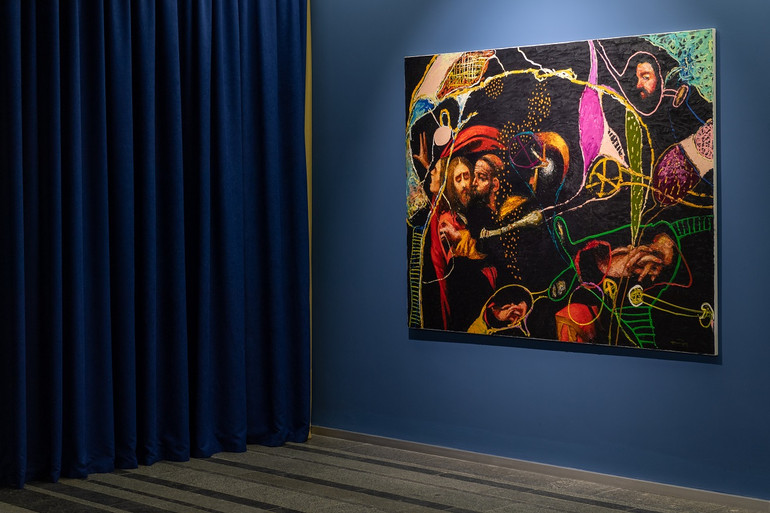
provided by the press service
In the description of the exhibition, the organizers quote Alexander Roitburd’s manifesto “Art and the State” from 1995:
“We are able to more effectively solve the issue of creating a new spiritual climate in culture and society, necessary at the stage of formation and reforms. We are able to help society get rid of stereotypes, become more open and dynamic. We are able to make a tangible contribution to the creation of a modern culture worthy of a European state, to give Ukraine relevant modern art, focused on global artistic issues…“
Back in the 90s, Roitburd notes for himself the program goals of Ukrainian art, the need to institutionalize and promote it in the world.
At the same time, Oleksandr Roitburd was the first artist of independent Ukraine whose project took part in the Venice Biennale. It happened in 2001. Among the artefacts of the Biennale are a photograph with then-curator Harald Zeeman and a catalog with an article about Roitburd’s work.
Under the glass – an award from “Ukrainian Pravda”, which was awarded to the artist posthumously, in 2021, in the “Artist of the Year” category. We see the power of the artist primarily as a social construct. His works are covered with recognition, applause, awards, contacts with the international art community.
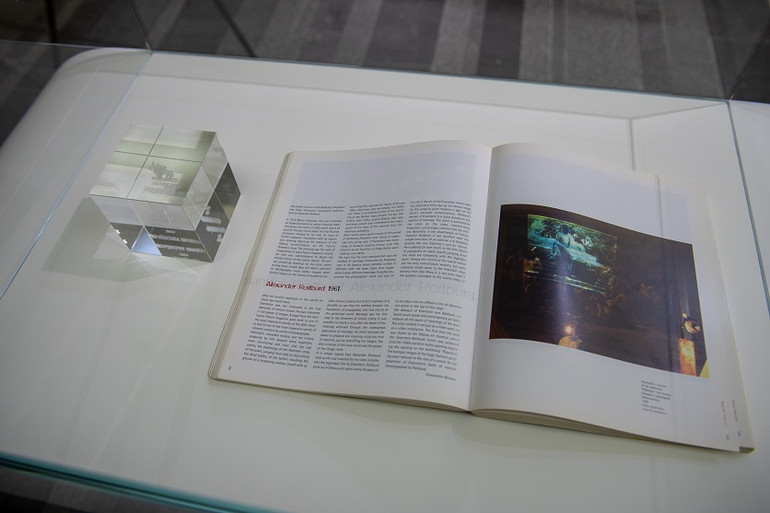
provided by the press service
In contrast, it is interesting to see how the artist portrays himself. Alexander Roitburd had a tradition of drawing a self-portrait at the end of each year, and two of them were placed in the first hall “Power Theorems”. You can follow them as the artist’s style changed, because the first one was written in 1981, when Roitburd was still a student. The second, one of the last, is in 2020, where the artist ironically wraps himself in the image of a saint.
Between them is the work “Bird” from 1994, where Roitburd creates a tribute to Marcel Duchamp. He puts wings on the urinal, appealing to the fact that an artist is not only a person who paints. Artists can use different mediums, and a similar idea was expressed by Duchamp in 1917, calling his urinal “Fountain”.
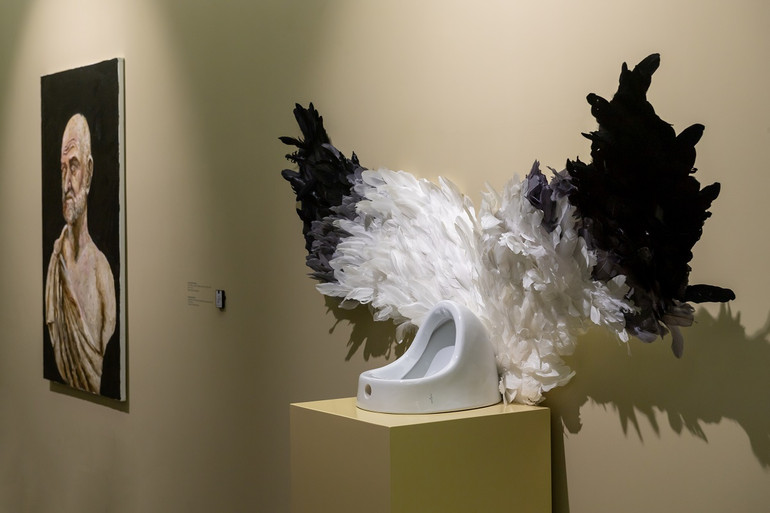
provided by the press service
Ultimately, we see how art does not shy away from its political function. It gives a voice to marginalized social groups, allows you to rethink important social shifts, to respond promptly to what you do not like in the life of your country.
Therefore, the next power, which the exhibition talks about, is the power of culture. This chapter is dedicated to Roitburd’s dialogue with famous figures of world culture that were of special importance to him. Among them are Susan Sontag, Johann Wolfgang Goethe, Arthur Schopenhauer and Ivan Drach. Roitburd believed that “talent, giftedness and courage of thinking gave a person the right to any extravagance and self-centeredness, freed from moral restrictions, justified practices unacceptable from the point of view of social norms or even common sense”.
In this context, it is interesting to think about where is the line between when you are allowed to do whatever you want and when you are not? What is invested in the concept of talent, giftedness and courage of thinking, which become a pass to the artistic world, where almost everything is allowed?
There are also several works that reveal Roitburd’s attitude to religion. “It is impossible and unnecessary to unify the world – this is one of Roitburd’s important ideas“, Kostyantyn Doroshenko explains.
Any religious precepts can be refuted, and they should not be perceived as dogma: in the painting “Buddha Fallen” (2003), the Buddha is on his head, upside down. In another, “Buddha Mamai” (2015), he becomes a Cossack, dressed in Ukrainian national clothes, which testifies to the contradictory nature of beliefs.
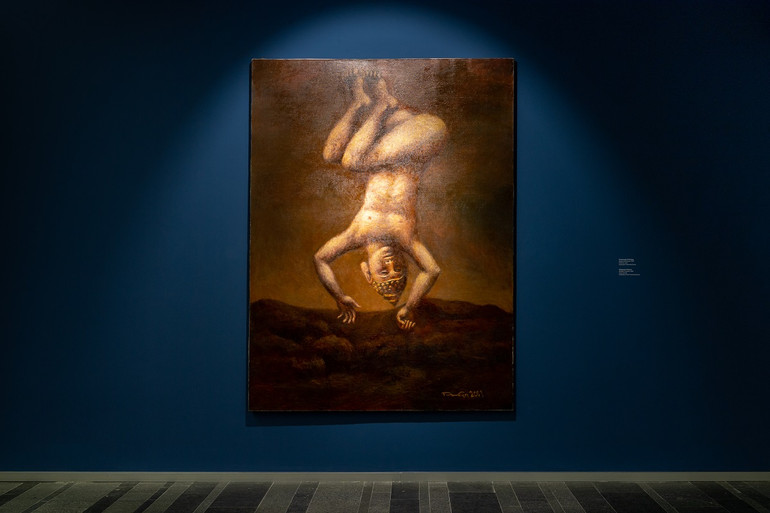
provided by the press service
The essence of each of the religions is supposedly similar. But they all divide groups of people and this is the dark side of every religion. Where within the group a person is ready to adapt to the prescriptions of a separate religion.
The artist’s power is rooted in his interdisciplinary nature. Roitburd, as a multifaceted person in her knowledge and skills, used not only visual art. Along with the presented paintings, we also see his book “Poems of a Dilettante”, published after Oleksandr’s death in 2021, illustrated by Serhiy Zhadan.
Roitburd considered his poems to be more of an intellectual game for himself and his friends, which is why he labels them “dilettante”. However, this is another attempt to use the artistic power that you are capable of.

Olga Dudenko
The second floor finally crystallizes the idea that culture is a political force. There are two works here that tell about the events of the Maidan, – “A premonition of a hybrid war” (2015) and “He Who Raises the Flag” (2014), written on the night of the execution of the Heavenly Hundred.
The bodies of the people in the picture are distorted, as is the reality in which they live. We are talking about hybrid warfare, which means that there is no certainty around whether you are getting reliable information and whether you can maintain contact with those with whom you communicated before.
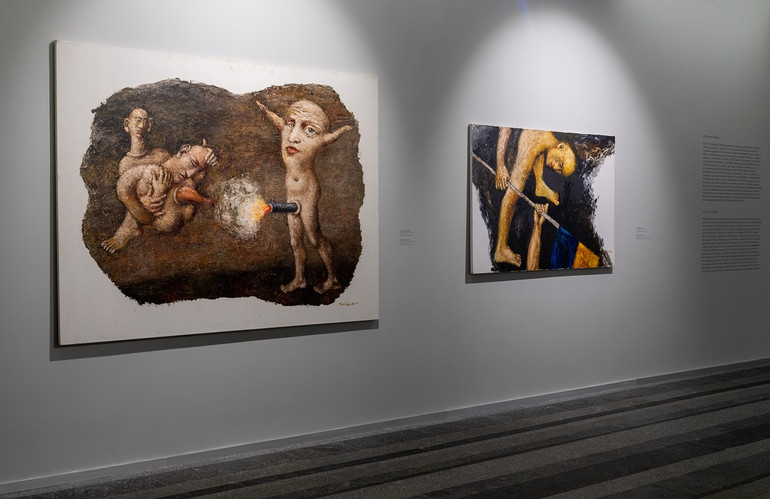
provided by the press service
There are many political faces in Roitburd’s works: Viktor Yushchenko on a horse, whom the artist openly ridicules; a wall with portraits of Viktor Yanukovych from the “Mezhyhirya Codex” exhibition, which Roitburd curated in 2014 at the National Art Museum and which demonstrates the distaste of Soviet practices of gifting things with portraits of state figures; a video where the artist mocks the former mayor of Odesa, Eduard Hurvitz, even though he supported him.

provided by the press service
For Roitburd, the opportunity to reflect on political changes and the activities of political figures was important, in particular, because his birth and upbringing in the Soviet Union did not in any way promote free expression of opinion. He understood on his own skin how a totalitarian system blocks any freedoms, and the power of the artist becomes impossible, because the artist realizes the function assigned to him by the state.

provided by the press service
The power that is mentioned last at the exhibition is the power of the body and the subconscious. Oleksandr Roitburd willingly explored physicality and sexuality in his own work and saw in it something that a person cannot get rid of. Roitburd protested against the classical anatomy of the human body and saw it in a different structure.
Such thoughts are expressed in the series “Everyday life in Pompeii” (from Bulgarian – “Everyday life in Pompeii”), where human bodies are distorted: we see a girl running without arms, a torso from which water flows, separated into two parts of the body , from inside of which hands stick out. Of great importance to everyday life in the ancient Roman city of Pompeii were various sexual practices, self-exploration, which resonates with Roitburd’s desire to deconstruct the body.

provided by the press service
Next to the bodily, they mention the subconscious – both individual and collective. The most terrifying thing for subconscious Roitburd is the return to the totalitarian system. That is why Oleksandr ridicules the totalitarian government and its bearers.
In one of his works, he paints a naked Lenin, as if posing in front of the artist. Next to it is a work that is being exhibited for the first time – a print from the series “Max Ernst Unknown” (1997). In it, Roitburd depicts the two leaders of North Korea, Kim Il-sung and Kim Jong-il, as people who on the modern map almost represent totalitarian power the most.
The artist knows that any government changes, and the Kim family will also leave the government sooner or later. But what remains after? Society, accustomed to total lack of freedom, is not ready to face all the opportunities that the world offers.

provided by the press service
Another facet of corporeality that Roitburd explores is sexuality. This is how he creates the “Gay Gothic” series, one of which works is presented on “Theorem of Power”. Previously, this painting was shown in 2001 at the Museum of the Ukrainian Diaspora – then, for the first time, a work on the LGBT theme was presented in a state museum.
In general, the exhibition presents many themes that will make the viewer feel tired and give him space to think about it afterwards. We see the political position of the artist, we observe how he grows, what variety of artistic tools he uses, which famous figures he refers to, but critically. But a look at Roitburd’s work in the broader context of modern Ukrainian art is still not enough.
So, despite the “non-retrospectiveness” of the exhibition declared by the curator, the Roitburd phenomenon remains as if locked in a vacuum. And builds dialogues only with dead artists. Not counting Zhadan.
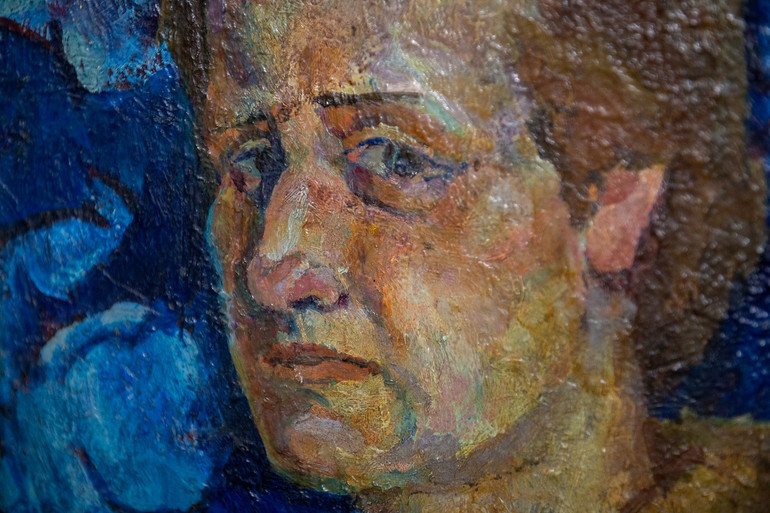
provided by the press service
In addition, apart from the voice of PinchukArtCenter head Bjorn and curator Kostyantyn Doroshenko, we do not hear female researchers Lesya Kulchynska, Galina Gleba, Daria Shevtsova and Kateryna Lazarevich, who collected Roitburd’s works over several years, analyzed them both before and during the full-scale war. Although collectively, their research optics are extremely important in looking at how Roitburd’s practice affected modern Ukrainian art and how the processes that took place in it influenced the vision of this artist.
The art center succeeds in creating a space to showcase and celebrate the importance of everything Roitburd created, but reinterpretations of him as an artist and as a person are left to the viewer.
[ad_2]
Original Source Link











